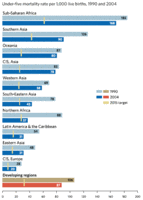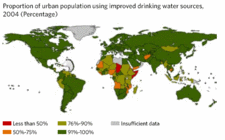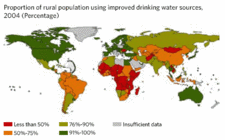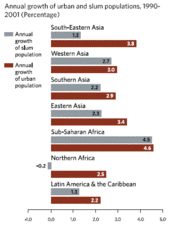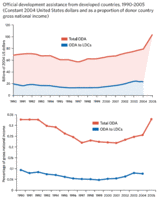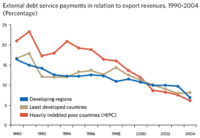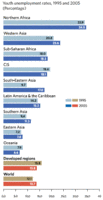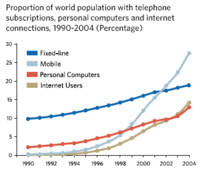Millennium Development Goals (MDGs)
Contents
- 1 Introduction
- 2 Goals, targets, and indicators
- 3 Data sources
- 4 Regional groupings
- 5 Progress as of 2006
- 5.1 Goal 1: Eradicate extreme hunger and poverty
- 5.2 Goal 2: Achieve universal primary education
- 5.3 Goal 3: Promote gender equality and empower women
- 5.4 Goal 4: Reduce child mortality
- 5.5 Goal 5: Improve maternal health
- 5.6 Goal 6: Combat HIV/AIDS, malaria & other diseases
- 5.7 Goal 7: Ensure environmental sustainability
- 5.8 Goal 8: Develop a global partnership for development
- 6 Further Reading
Introduction
The Millennium Development Goals (MDGs) were derived from the United Nations Millennium Declaration (Millennium Development Goals (MDGs)) , adopted by 189 nations in 2000. Most of the goals and targets were set to be achieved by the year 2015 on the basis of the global situation during the 1990s. It was during that decade that a number of global conferences had taken place and the main objectives of the development agenda had been defined. The baseline for the assessment of progress is therefore 1990 for most of the MDG targets.
The Millennium Development Goals are the world's time-bound and quantified targets for addressing extreme poverty in its many dimensions—income poverty, hunger, disease, lack of adequate shelter, and exclusion—while promoting gender equality, education, and environmental sustainability. They are also basic human rights—the rights of each person on the planet to health, education, shelter, and security.
Goals, targets, and indicators
Goal 1: Eradicate Extreme Hunger and Poverty
-- Target 1. Halve, between 1990 and 2015, the proportion of people whose income is less than $1 a day
-- Target 2. Halve, between 1990 and 2015, the proportion of people who suffer from hunger
Goal 2: Achieve Universal Primary Education
-- Target 3. Ensure that, by 2015, children everywhere, boys and girls alike, will be able to complete a full course of primary schooling
Goal 3: Promote Gender Equality and Empower Women
-- Target 4. Eliminate gender disparity in primary and secondary education, preferably by 2005, and in all levels of education no later than 2015
Goal 4: Reduce Child Mortality
-- Target 5. Reduce by two-thirds, between 1990 and 2015, the under-five mortality rate
Goal 5: Improve Maternal Health
-- Target 6. Reduce by three-quarters, between 1990 and 2015, the maternal mortality ratio
Goal 6: Combat HIV/AIDS, Malaria and other diseases
-- Target 7. Have halted by 2015 and begun to reverse the spread of HIV/AIDS
-- Target 8. Have halted by 2015 and begun to reverse the incidence of malaria and other major diseases
Goal 7: Ensure Environmental Sustainability
-- Target 9. Integrate the principles of sustainable development into country policies and programs and reverse the loss of environmental resources
-- Target 10. Halve, by 2015, the proportion of people without sustainable access to safe drinking water and basic sanitation
-- Target 11. Have achieved by 2020 a significant improvement in the lives of at least 100 million slum dwellers
Goal 8: Develop a Global Partnership for Development
-- Target 12. Develop further an open, rule-based, predictable, nondiscriminatory trading and financial system (includes a commitment to good governance, development, and poverty reduction; both nationally and internationally)
-- Target 13. Address the special needs of the Least Developed Countries (includes tariff- and quota-free access for Least Developed Countries; exports, enhanced program of debt relief for heavily indebted poor countries (HIPCs) and cancellation of official bilateral debt, and more generous official development assistance for countries committed to poverty reduction)
-- Target 14. Address the special needs of landlocked developing countries and small island developing states (through the Program of Action for the Sustainable Development of Small Island Developing States and 22nd General Assembly provisions)
-- Target 15. Deal comprehensively with the debt problems of developing countries through national and international measures in order to make debt sustainable in the long term
Some of the indicators listed below are monitored separately for the least developed countries, Africa, landlocked developing countries, and small island developing states
-- Target 16. In cooperation with developing countries, develop and implement strategies for decent and productive work for youth
-- Target 17. In cooperation with pharmaceutical companies, provide access to affordable essential drugs in developing countries
-- Target 18. In cooperation with the private sector, make available the benefits of new technologies, especially information and communications technologies
Data sources
Data to monitor progress towards the Millennium Development Goals are compiled by specialized agencies within their area of expertise. They are drawn from national statistics provided by Governments to the international statistical system—the United Nations Statistics Division and the statistical offices of the various international organizations—and adjusted for comparability. In some cases, national Governments may have more recent statistics that have not been reported to the international statistical system. In other cases, countries do not produce the data required for the compilation of indicators. When this occurs, international statistical agencies make estimates based on the data of neighboring countries or of countries with similar levels of income. Most of the organizations and agencies of the United Nations system, along with the Organization for Economic Cooperation and Development and the Inter-Parliamentary Union, contribute to this exercise.
Many of the indicators—for example, on child mortality and malnutrition, malaria prevention and treatment, and knowledge of and behavior related to HIV/AIDS—are derived from surveys sponsored and carried out by international agencies. These include, most importantly, the Multiple Indicator Cluster Surveys and the Demographic and Health Surveys, which help fill the frequent data gaps that exist.
Regional groupings
 Under-five mortality rate per 1,000 live births, 1990 and 2004. (Source:MDG)
Under-five mortality rate per 1,000 live births, 1990 and 2004. (Source:MDG) The Millennium Development Goals are reported for the world as a whole and for various country groupings. These are classified as "developing" regions, the transition economies of the Commonwealth of Independent States (CIS) in Asia and Europe, and the "developed" regions. The developing regions are further broken down into the subregions shown on the map to the right. These regional groupings are based on United Nations geographical divisions, with some modifications necessary to create, to the extent possible, groups of countries for which a meaningful analysis can be carried out.
Progress as of 2006
Goal 1: Eradicate extreme hunger and poverty
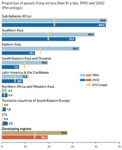 Under-five mortality rate per 1,000 live births in developing regions, by household wealth and mother’s education, 1995/2004. (Source:MDG)
Under-five mortality rate per 1,000 live births in developing regions, by household wealth and mother’s education, 1995/2004. (Source:MDG)  Percentage of children (12-23 months old) immunized against measles, 1990 and 2004 (Percentage). (Source:MDG)
Percentage of children (12-23 months old) immunized against measles, 1990 and 2004 (Percentage). (Source:MDG) In 1990, more than 1.2 billion people – 28 percent of the developing world’s population – lived in extreme poverty. By 2002, the proportion decreased to 19 percent. During that period, rates of extreme poverty fell rapidly in much of Asia, where the number of people living on less than $1 a day dropped by nearly a quarter of a billion people. Progress was not so rapid in Latin America and the Caribbean, which now has a larger share of people living in poverty than South-Eastern Asia and Oceania. Poverty rates in Western Asia and Northern Africa remained almost unchanged between 1990 and 2002 and increased in the transition economies of South-Eastern Europe and the Commonwealth of Independent States (CIS). These two regions had previously nearly eradicated the worst forms of poverty, and recent survey data suggest that their poverty rates are again dropping. In sub-Saharan Africa, although the poverty rate declined marginally, the number of people living in extreme poverty increased by 140 million. Many sub-Saharan countries are now showing potential for long-term growth that could bring up standards of living.
Chronic hunger – measured by the proportion of people lacking the food needed to meet their daily needs – has declined in the developing world. But progress overall is not fast enough to reduce the number of people going hungry, which increased between 1995-1997 and 2001-2003. An estimated 824 million people in the developing world were affected by chronic hunger in 2003.
The worst-affected regions – sub-Saharan Africa and Southern Asia – have made progress in recent years. But their advances have not kept pace with those of the early 1990s, and the number of people going hungry is increasing. Of particular concern is Eastern Asia: in the early 1990s, the number of hungry people declined; but again it is on the rise.
Goal 2: Achieve universal primary education
Net enrolment ratios in primary education have increased to 86 percent in the developing world, ranging from 95 percent in Latin America and the Caribbean to 64 percent in sub-Saharan Africa. Although the sub-Saharan region has made significant progress since 1990/1991, in Burkina Faso, Djibouti, Eritrea, Ethiopia, Mali, and Niger, fewer than half the children of primary-school age are enrolled in school. Faster progress will also be needed if Oceania and Western Asia are to achieve universal education. Southern Asia, in contrast, has made great strides, especially over the period 1999-2004, when enrolment rose from 72 to 89 percent — largely as a result of progress in India.
Educating all children presents a significant challenge due to the large number of children who live in remote, rural areas of developing countries. High rates of poverty in rural areas limit educational opportunities because of demands for children’s labor, low levels of parental education and lack of access to good quality schooling. Based on household surveys in 80 developing countries, 30 percent of rural children of primary-school age do not attend school, compared to 18 percent in urban areas. And because rural areas have larger populations of children, they account for 82 percent of children who are not in school in developing countries.
Globally, more than one in five girls of primary-school age are not in school, compared to about one in six boys. Oceania, Western Asia and Southern Asia are the regions where the gender gap is most evident. Of particular concern is the wide gender gap in sub-Saharan Africa and Southern Asia, where almost 80 percent of the world’s out-of-school children live.
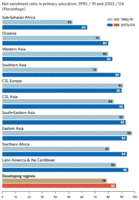 Proportion of deliveries attended by skilled health care personnel, 1990 and 2004 (Percentage). (Source:MDG)
Proportion of deliveries attended by skilled health care personnel, 1990 and 2004 (Percentage). (Source:MDG) 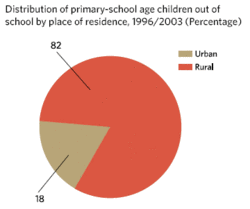 Number of new tuberculosis cases per 100,000 population (excluding people that are HIV-positive), 1990 and 2004. (Source:MDG)
Number of new tuberculosis cases per 100,000 population (excluding people that are HIV-positive), 1990 and 2004. (Source:MDG) 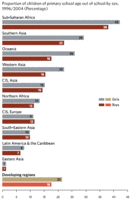 HIV prevalence in adults aged 15-49 in sub-Saharan Africa and all developing regions (Percentage) and number of AIDS deaths in sub-Saharan Africa (Millions), 1990-2005. (Source:MDG)
HIV prevalence in adults aged 15-49 in sub-Saharan Africa and all developing regions (Percentage) and number of AIDS deaths in sub-Saharan Africa (Millions), 1990-2005. (Source:MDG)
Goal 3: Promote gender equality and empower women
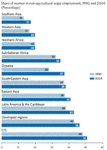 Mosquito nets sold or distributed in sub-Saharan Africa, 1999-2003 (Millions). (Source:MDG)
Mosquito nets sold or distributed in sub-Saharan Africa, 1999-2003 (Millions). (Source:MDG)  Proportion of land area covered by forests, 1990 and 2005 (Percentage). (Source:MDG)
Proportion of land area covered by forests, 1990 and 2005 (Percentage). (Source:MDG) Women represent an increasing share of the world’s labor force – over a third in all regions except Southern and Western Asia and Northern Africa. However women remain at a disadvantage in securing paid jobs. Wage differentials, occupational segregation, higher unemployment rates and their disproportionate representation in the informal and subsistence sectors limit women’s economic advancement. Sociocultural attitudes, employment policies and a lack of options for balancing work and family responsibilities or for controlling the timing and spacing of births contribute further to inequality in the labor market.
Women’s political participation has increased significantly since 1990. One in five parliamentarians elected in 2005 are women, bringing the percentage of parliamentary seats held by women in 2006 worldwide to almost 17. In 20 countries, more than 30 percent of parliamentarians are women. Striking disparities remain, however. While Rwanda and the Nordic countries have come close to parity, women’s national political representation is very low in Oceania, Northern Africa, and Western Asia. The most encouraging signs come from Latin America and the Caribbean, where women now hold 20 percent of parliamentary seats.
Several factors are at work. Public debate and advocacy have shifted the political landscape. Quotas and other measures have broken barriers and triggered positive change. More than 95 countries have now implemented either mandatory or voluntary measures to increase women’s political participation. New constitutions in countries emerging from conflict have been especially effective in this regard: After the 2005 elections in Afghanistan and in Iraq, for example, women now represent 27 and 25 percent of parliamentary seats, respectively.
Goal 4: Reduce child mortality
Though survival prospects have improved in every region, 10.5 million children died before their fifth birthday in 2004 – mostly from preventable causes. The vast majority of these children (94 percent) lived in 60 countries. Sub-Saharan Africa, with only 20 percent of the world’s young children, accounted for half of the total deaths, a situation that has shown only modest improvement. In contrast, child survival has improved markedly in Latin America and the Caribbean, South-Eastern and Eastern Asia, and Northern Africa, where child mortality rates have declined by more than 3 percent annually.
Disparities in child deaths are pronounced both within and among countries. Survival rates for children of mothers with at least a secondary education are twice as high as those for children with less-educated mothers. Similarly, children living in the wealthiest 20 percent of households are twice as likely to survive as those in the poorest 20 percent of households. Addressing these disparities and reaching the most disadvantaged groups is the greatest challenge to achieving the child mortality target by 2015.
The vaccination of three quarters of the world’s children has proven to be one of the most cost-effective public health interventions on record. Nevertheless, the disease killed 454,000 children in 2004, leaving others blind or deaf. Two thirds of the world’s unprotected children live in six countries: China, the Democratic Republic of the Congo, India, Indonesia, Nigeria, and Pakistan. Latin America and the Caribbean made the greatest strides in immunizing children, with sub-Saharan Africa showing significant progress as well. Sub-Saharan Africa also achieved the largest reduction in deaths from measles: a decrease of nearly 60 percent between 1999 and 2004. This overall progress masks wide inequalities within countries: In Chad and Nigeria, for example, children of educated mothers are two to almost four times, respectively, more likely to be vaccinated than children of mothers with no education. The gaps are even wider when children from richer and poorer households are compared.
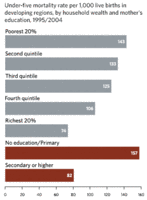 Energy use per unit of GDP, 1990 and 2003 (Kilograms of oil equivalent per 1,000 dollars of GDP in 2000 purchasing power parities). (Source:MDG)
Energy use per unit of GDP, 1990 and 2003 (Kilograms of oil equivalent per 1,000 dollars of GDP in 2000 purchasing power parities). (Source:MDG) 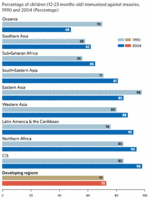 Emissions of carbon dioxide (CO2), 1990-2003 (Billions of metric tons). (Source:MDG)
Emissions of carbon dioxide (CO2), 1990-2003 (Billions of metric tons). (Source:MDG)
Goal 5: Improve maternal health
 Proportion of population using improved sanitation, 1990 and 2004 (Percentage). (Source:MDG)
Proportion of population using improved sanitation, 1990 and 2004 (Percentage). (Source:MDG) Though the issue has been high on the international agenda for two decades, ratios of maternal mortality seem to have changed little in regions where most deaths occur (sub-Saharan Africa and Southern Asia). Unreliable data and wide margins of uncertainty make it difficult to tell for sure. Adequate reproductive health services and family planning are essential in improving maternal health and reducing maternal mortality. But some 200 million women who wish to space or limit their childbearing lack access to contraception. Skilled attendants at delivery, backed up by referrals to timely emergency obstetric care, can reduce deaths further, as a growing number of countries have demonstrated.
Skilled care at delivery is one of the key elements necessary to reduce maternal mortality. Though all regions show improvement, only 46 percent of deliveries in sub-Saharan Africa, where almost half the world’s maternal deaths occur, are assisted by skilled attendants. In Southern Asia, the proportion is even lower. Eastern and South-Eastern Asia and Northern Africa have made the most headway, with increases in attended births of between 55 and almost 80 percent.
Within countries, the presence of a skilled attendant at delivery is the most inequitably distributed among child and maternal health indicators. Impoverished and rural women are far less likely than their urban or wealthier counterparts to receive skilled care during childbirth. Inequality between urban and rural care at delivery is particularly significant in sub-Saharan Africa: For 33 countries with data, urban women are over three times more likely to deliver with health personnel than women in rural areas. And women in the wealthiest fifth of the population are six times more likely to deliver with a health professional than those in the poorest fifth. Redressing these inequities will require continued analysis of trends matched by targeted policies.
Goal 6: Combat HIV/AIDS, malaria & other diseases
 Proportion of urban population using improved drinking water sources, 2004 (Percentage). (Source:MDG)
Proportion of urban population using improved drinking water sources, 2004 (Percentage). (Source:MDG) 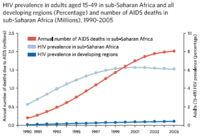 Proportion of rural population using improved drinking water sources, 2004 (Percentage). (Source:MDG)
Proportion of rural population using improved drinking water sources, 2004 (Percentage). (Source:MDG) 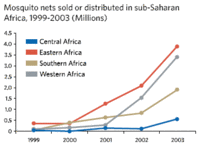 Annual growth of urban and slum populations, 1990-2001 (Percentage). (Source:MDG)
Annual growth of urban and slum populations, 1990-2001 (Percentage). (Source:MDG) Several countries report success in reducing HIV infection rates, through interventions that promote behavior change. However, rates of infection overall are still growing. And the number of people living with HIV has continued to rise, from 36.2 million in 2003 to 38.6 million in 2005 (nearly half of whom are women). There were 4.1 million new infections in 2005. The number of AIDS-related deaths also increased that year, to 2.8 million, despite greater access to antiretroviral treatment and improved care in some regions.
The epidemic remains centered in sub-Saharan Africa. With just over 10 percent of the world’s people, the region is home to 64 percent of HIV-positive people and to 90 percent of children (under 15) living with the virus. Twelve million sub-Saharan African children are orphans. Around 59 percent of HIV-positive adults in sub-Saharan Africa – a total of 13.2 million people – are women.
Rates of new HIV infections in the region peaked in the late 1990s, and prevalence rates in Kenya, Zimbabwe and in urban areas of Burkina Faso show recent declines. HIV prevalence among people aged 15 to 49 in sub-Saharan Africa appears to be leveling off, though at extremely high levels. This apparent stabilization reflects the fact that as new people acquire the virus, nearly the same number die from AIDS.
A growing awareness of [[malaria]’s] heavy toll has been matched with greater commitment to curtail it. Increased financial flows from the Global Fund to Fight AIDS, Tuberculosis, and Malaria, the World Bank’s Global Strategy and Booster Programme, the United States President’s Malaria Initiative and the Bill and Melinda Gates Foundation, among others, are expected to spur key malaria-control interventions, particularly insecticide-treated net use and access to effective antimalarial drugs.
In just four years (1999-2003), distribution of insecticide-treated mosquito nets increased 10-fold in sub-Saharan Africa. Despite this progress, urban dwellers are six times more likely to use the nets than their rural counterparts, according to data available from a number of countries in the region. Similarly, the richest fifth of the population are 11 times more likely to use them than the poorest fifth.
The number of new tuberculosis cases is growing by about 1 percent per year, with the fastest increases in sub-Saharan Africa. In the Commonwealth of Independent States, incidence increased during the 1990s, but peaked around 2001, and has since fallen. Tuberculosis kills 1.7 million people a year. Of nearly 9 million new cases in 2004, 741,000 were among people living with HIV.
Goal 7: Ensure environmental sustainability
 Official development assistance from developed countries, 1990-2005 (Constant 2004 United States dollars and as a proportion of donor country gross national income). (Source:MDG)
Official development assistance from developed countries, 1990-2005 (Constant 2004 United States dollars and as a proportion of donor country gross national income). (Source:MDG) 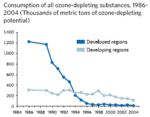 Proportion of imports from developing countries (excluding arms and oil) admitted to developed countries duty-free, 1996-2004 (Percentage). (Source:MDG)
Proportion of imports from developing countries (excluding arms and oil) admitted to developed countries duty-free, 1996-2004 (Percentage). (Source:MDG)  External debt service payments in relation to export revenues, 1990-2004 (Percentage). (Source:MDG)
External debt service payments in relation to export revenues, 1990-2004 (Percentage). (Source:MDG) Deforestation, primarily the conversion of forests to agricultural land, continues at an alarmingly high rate – about 13 million hectares per year. Forest planting, landscape restoration, and natural expansion of forests have significantly reduced the net loss of forest area. However, these newly replanted lands do not have the ecological value of older, more biologically diverse forests, and do not provide the same benefits and livelihoods for local communities. The net decrease in forest area over the period 2000-2005 is about 7.3 million hectares per year (an area about the size of Sierra Leone or Panama), down from 8.9 million hectares per year from 1990 to 2000. Still, the current net loss is equivalent to about 200 square kilometers per day.
Protection of the ozone layer is a global success story. The 1987 Montreal Protocol catalyzed global action to reduce use of chemicals damaging to the ozone layer that shields the Earth from ultraviolet radiation. Since that agreement, developed countries have virtually eliminated ozone-depleting substances, and the developing world is not far behind. Without these reductions, ozone depletion would have increased tenfold by 2050 compared to current levels, resulting in millions more cases of melanoma, other cancers and eye cataracts.
Since 1990, the ratio of energy used per $1,000 of Gross Domestic Product (GDP) decreased by about 10 percent globally, with transition economies and Eastern and Southern Asia showing greatest gains in efficiency. This has helped keep the rate of increase of carbon dioxide (CO2) emissions, which are associated with global climate change (Causes of climate change), slightly lower than the overall growth of energy consumption. Per capita CO2 has remained fairly constant between 1990 and 2003, at 4 metric tons per person. But due to population and economic growth, overall CO2 emissions continue to rise, especially in the developing world, where growth has been most rapid. Greater efforts are needed to develop and transfer cleaner energy technologies and fuels to developing countries that are beginning to invest more heavily in energy-intensive activities.
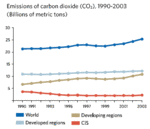 Youth unemployment rates, 1995 and 2005 (Percentage). (Source:MDG)
Youth unemployment rates, 1995 and 2005 (Percentage). (Source:MDG) Between 1990 and 2004, sanitation coverage in the developing world increased from 35 to 50 percent. This meant that 1.2 billion people gained access to sanitation during this period. Another 300 million people should have been served, however, to keep the world on track towards the 2015 target.
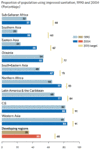 Proportion of world population with telephone subscriptions, personal computers and internet connections, 1990-2004 (Percentage). (Source:MDG)
Proportion of world population with telephone subscriptions, personal computers and internet connections, 1990-2004 (Percentage). (Source:MDG) The share of people using drinking water from improved sources has continued to rise in the developing world, reaching 80 percent in 2004, up from 71 percent in 1990. This means that the world is on track to reach the drinking water target. Growing populations pose a challenge, however, and wide disparities among countries and between rural and urban areas persist. The largest urban-rural disparities are found in parts of sub-Saharan Africa, where city dwellers are twice as likely to have safe water as their rural counterparts.
In 2007, for the first time in history, the majority of people will live in urban areas. Throughout most of the developing world, this will result in larger slum populations. Sub-Saharan Africa is the world’s most rapidly urbanizing region, and almost all of this growth has been in slums, where new city residents face overcrowding, inadequate housing, and a lack of water and sanitation. In Western Asia, as well, most of the urban growth is occurring in slums. The rapid expansion of urban areas in Southern and Eastern Asia is creating cities of unprecedented size and complexity and new challenges for providing a decent environment for the poor. Northern Africa is the only developing region where the quality of urban life is improving: In this region, the proportion of city dwellers living in slums has decreased by 0.15 percent annually.
Goal 8: Develop a global partnership for development
Aid to developing countries has increased steadily since 1997, reaching $106 billion – one third of one percent of donors’ combined national income – in 2005. Debt relief accounted for over half of the increase since 1997 and three quarters of it in 2005. This relief, while welcome, will not necessarily release more money for poverty reduction. Similarly, emergency and disaster relief, also a large part of the increase in aid, although essential, does not address long-term development needs. Other forms of aid rose by 9 percent in 2005, continuing a recovery that started in 2004. The 50 least developed countries now receive about one third of all aid flows, and donors have pledged to double aid to Africa, where most of these countries are located, by 2010.
Only five countries — Denmark, Luxembourg, the Netherlands, Norway, and Sweden — have met the United Nations aid target of 0.7 percent of gross national income. Eleven more European Union countries have pledged to do so by 2015. If all donors honor their commitments, aid is expected to reach $130 billion by 2010.
Developing countries have gained greater access to markets over the past decade. Three quarters of their exports entered developed country markets duty-free in 2004, with the figure rising to 79 percent for the least developed countries. However, goods that are strategically important to developing economies, such as clothing and farm products, are still heavily taxed.
A major objective of ongoing negotiations in the World Trade Organization is to further reduce such trade barriers. Developed countries have committed themselves in principle to duty-free and quota-free imports from least developed countries. However, further meaningful reductions will require considerable political determination.
Future debt payments for 29 heavily indebted countries have fallen by $59 billion since 1998, bringing their debt service to less than 7 percent of export earnings. But for many poor countries, even this reduced level is too high. In 2005, leaders of the Group of 8 industrialized nations pledged to cancel the debt of heavily indebted countries that meet certain criteria, including a track record of sound macroeconomic performance. The International Development Association of the World Bank, the International Monetary Fund and the African Development Fund will cancel debts to 19 countries that have met the requirements of the enhanced Heavily Indebted Poor Countries (HIPC) Initiative. Eleven other countries remain potentially eligible for debt relief under the initiative, but are kept out of the running by conflict, poor governance and arrears in payments.
The number of young people, and their share in the population, has increased dramatically in developing countries. Many face grim job prospects. Since 1995, the number of young people worldwide has grown by 135 million; during that same period, youth unemployment has risen from 72.8 to 85.7 million. Youth now represent close to half of the world’s 192 million jobless people. In many countries, they are more than three times as likely as adults to be seeking work.
Without sufficient employment opportunities, many young people grow discouraged and feel worthless. This presents an especially urgent challenge for developing countries, home to 85 percent of the world’s youth. Being young and female can be a double disadvantage: young women often have the most difficulty entering the labor market and retaining decent jobs. In many countries, they are forced to emigrate in search of work and face the risk of being trafficked or coerced into labor.
The integration of youth, especially those from underprivileged households, into the labor market, is important for future growth and for stopping the intergenerational transmission of poverty. In the words of the UN Secretary-General, youth are our most valuable asset for the future, and, as such, must be nurtured.
Access to essential drugs, especially those for treating HIV, has expanded in the developing world. Between 2001 and 2005, the number of people on antiretroviral therapy in low- and middle-income countries increased fivefold, from 240,000 to 1.3 million. The scale-up was most dramatic in sub-Saharan Africa: from 100,000 at the end of 2003 to 810,000 just two years later. Prices of antiretroviral drugs have decreased significantly, generic drugs have become more widely available and drug procurement systems have improved. But the target set in 2003 of reaching at least half of those in need of therapy has been missed, and antiretroviral drugs reach only one in five globally.
Access to information and communication technologies continues to outpace global economic growth. The number of subscribers to fixed and mobile telephones rose from 530 million in 1990 to almost 3 billion (about half of the world’s population) in 2004. Growth has been especially rapid in the mobile sector, which offers access to telecommunications in regions where there is a limited number of fixed lines. In 2004, Africa added some 15 million new mobile phone subscribers. This figure is equivalent to the total number of fixed and mobile telephone subscribers on the continent in 1996.
By the end of 2004, 14 percent of the world’s population were using the Internet, with a large digital divide separating developed and developing regions: Over half the population in developed regions had access to the Internet, compared to 7 percent in developing regions and less than 1 percent in the 50 least developed countries.
Further Reading
| Disclaimer: This article is taken wholly from, or contains information that was originally published by, the United Nations. Topic editors and authors for the Encyclopedia of Earth may have edited its content or added new information. The use of information from the United Nations should not be construed as support for or endorsement by that organization for any new information added by EoE personnel, or for any editing of the original content. |
